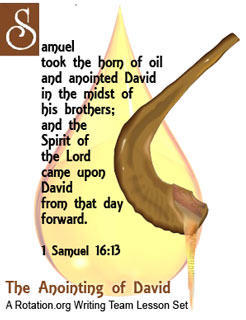Anointing of David
Art Workshop
 Summary of Lesson Activities:
Summary of Lesson Activities:
In this workshop, the learners will hear the story of the anointing of David as the future king of Israel. They will discover what characteristics society values in people and what characteristics God values in people. Silhouettes of themselves will be used to help them remember these desirable characteristics.
Scripture Reference:
1 Samuel 16:1-13
Key Verse:
1 Samuel 16:7b: "...for the Lord does not see as mortals see; they look on the outward appearance, but the Lord looks on the heart."
Workshop Objectives — After completing this Rotation, participants will know that:
- God chooses ordinary, often marginalized, people to do God’s work in the world.
- David is identified by God to be the king of Israel, the leader of God’s people.
- God looks at the heart, not at outward appearances.
Leader Preparation:
- Read the Bible passage.
- Read over the background material included in your teacher packet as you become familiar with the Bible story and the lesson plan.
- Gather the materials.
Supplies List:
- The story of the anointing of David, copied from The Storytellers Series: The Shepherd King
- Several advertisements from magazines that have people in them
- Newsprint and marker
- 5’ to 6’ lengths of paper (one per student)
- Crayons
- Masking tape (or blue tape)
- Newspapers, cotton balls, & vegetable oil (for Beginner class only; optional for other classes).
Advanced Preparation Requirements:
- Tape long pieces of paper to the wall, with the bottom of the paper to the floor. You should have a mixture of lengths of paper to accommodate various sizes of children.
Presentation
Opening – Welcome & Lesson Introduction:
Greet the children and introduce yourself. Remember that you are interacting with a different group of students each week—some may not know you. Wear your nametag and make sure that the children are wearing theirs.
Dig - Main Content & Reflection:
Gather the children around and read the story from the copy provided.
Ask the following:
- What were some of the characteristics Samuel was looking for in choosing the next king? (height, muscle power, good-looking, curly hair, etc.)
- What are the qualities of a good leader? (Let them name some. You might add integrity, honesty, empathy, love, and others you think are important if they are not named.)
- Why do you think God passed over the older brothers and chose David? (God knew he had a good heart; he was young and would develop right characteristics with the spirit of God to help him.)
Talk a little bit about outward appearances.
Ask: What are some of the aspects of outward appearance that are considered important in our society?
What are some material things to have that are considered important in our society? (cool clothing, car, big house, “right” friends, etc.)
Do: Lay out all the magazine ads on the table. Have each of them look through them and choose an advertisement that interests them and pick it up.
One by one, let each person show their ad.
As a group, discuss the kind of persons the ads describe or imply as ideal. List on the newsprint the attributes seemingly preferred in the ads.
Discuss whether each attribute is related to a person’s outward appearance or a person’s heart. On another sheet of paper, make a list of the attributes that God may look for in preparing us for God’s work.
Draw attention to the long pieces of paper on the walls. Let each child find one that is close to their own size, and stand in front of it. In pairs, have one person stand with his or her back to the paper and the other draw their outline on the paper with a crayon. (You and the shepherd may need to help with this, too.)
For Primaries and Juniors
When everyone has a silhouette, give these instructions to the whole group:
- First, they are to write on their papers, outside the silhouette, details of their personal appearance, such as height, hair color, or shoe size.
- Then ask them to write, inside their silhouettes, personal characteristics that are not visible, such as friendliness, honesty, faith, love of family, etc. Older students might benefit from drawing a line down the middle of their silhouette, and listing the "Godly" characteristics on one side, vs, the "worldly characteristics" on the other.
- When all have finished, have each one stand by their silhouette and tell what is written on it. Ask:
What is wrong with a good personal appearance? (Actually, nothing. Taking care of ourselves is taking care of God. But this alone doesn’t make us ready for doing God’s work.)
What characteristics mentioned on the silhouettes might you look for in choosing different kinds of leaders? (Answers here might depend on the leadership role that needs filling.
Sometimes physical characteristics are desirable in leadership roles, but most often good inner qualities are desirable in leaders. Inner characteristics determine what we can do for God.)
What people in your life might be measuring your heart for filling important roles?
For Beginners
Spread several layers of newspaper on the table (get the children to help if needed.)
Take the silhouettes off the wall and lay them on the newspaper.
Ask the children to turn theirs over and draw a heart or other decorations on the blank side with crayons. When done, have them turn their papers back to the figure side.
Ask: How well can you see the heart and the other decorations you drew?
Provide each child with a cotton ball dipped in vegetable oil. Have them rub the oily cotton over the figure. Show excitement as their hearts and decorations appear on the figures. Remind them that God can see through to the inside and to our hearts just like God saw through to David’s heart.
Ask for volunteers to explain how this activity relates to the story they have heard about David.
Ask:
- Thinking about this story in another way, how do we choose our friends?
- What if our friends don’t like someone else we know?
- How should we respond to those who are mentally or physically challenged or of a different culture?
(If the students don’t answer a question, be prepared to give prompts. However, don’t judge any answers, but talk about how Jesus teaches us to answer.)
Remember that we can only see on the outside, but God can see the heart.
What "clues" might we have to a person's heart?
Closing:
Close the class with a prayer of your own, or use the following:
Gracious God, thank you for choosing us and preparing us for important roles. Guide us as we meet people in our lives so that we do not judge them by how they look but with open minds. Help us to see people as you see them, as your children. Amen.
Journal Time:
Help the shepherd pass out the journals. Have the answer the following:
What good qualities might God see in your heart?
Adjustment for older classes:
If you have time, feel free to have the primary and junior classes do the drawing/oil exercise in steps 7 and 8 after you have completed step 6 of their section. They may enjoy this, too.
References:
- Wehrheim, Carol A., editor, The Storyteller Series: The Shepherd King, Age-Level Leaders’ Guide, 1997, Christian Board of Publication, St. Louis, MO.
A lesson written by Jan Marshall from: Brenthaven Cumberland Presbyterian\
Brentwood, TN. 2009
A representative of Rotation.org reformatted this post to improve readability.




